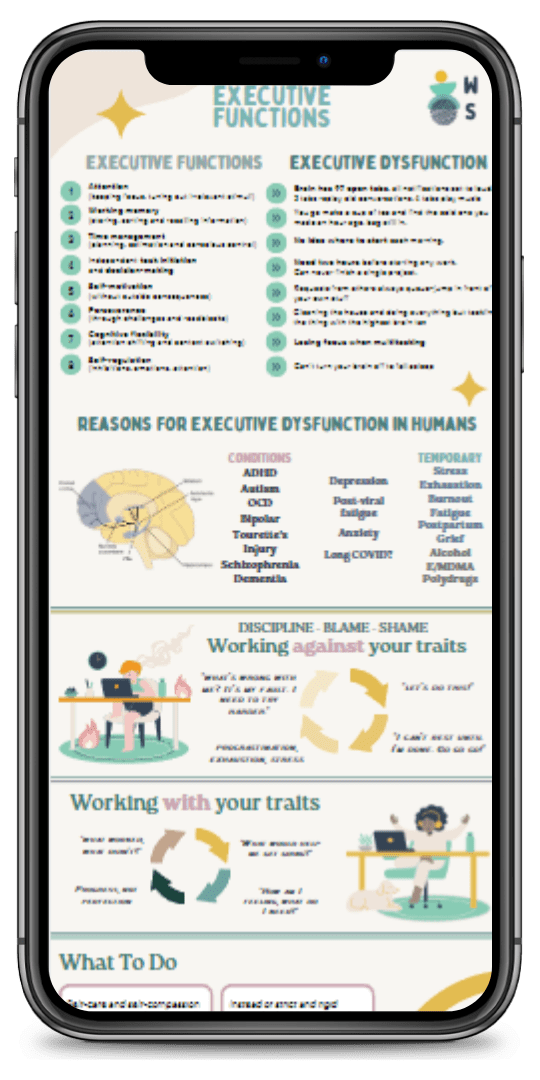Body doubling means sharing space with someone while doing activities – they might be doing their own thing or just being present. While from the outside it might look like two people simply occupying the same room, the experience of body doubling is much more meaningful: it creates a supportive, anchoring presence that helps make tasks and activities more manageable.
This natural strategy is similar to parallel play in children, where kids play independently alongside each other. Adults often instinctively seek out this kind of parallel engagement too – working in cafes, studying in libraries with friends, or doing household tasks while someone else is around.
Many people use body doubling without realizing it has a name, finding it easier to focus or start tasks when someone else is sharing their space.
The presence of another person helps create context and safety for engaging with tasks — without adding pressure or expectations. It’s one of the strategies for managing focus and creating a flow for work, even when you feel lost and overwhelmed by executive dysfunction. It’s not about having someone watch over you or hold you accountable – it’s about having a supportive presence that helps you feel more grounded and capable of tackling whatever you want to work on.
Table of Contents[Hide][Show]
How does body doubling work?
Body doubling is a form of social motivation – meaning that when you’re doing something together with someone else, you can sync up, and their presence can help you regulate your thoughts and focus on the thing you’re doing. It’s an anchoring technique that gives a supportive structure to rely on.
Regulating emotions, focus and temperature with other humans has been in our evolutionary toolkit for a long time. Think of how cuddling helps some people fall asleep easier or break fevers even if they are not babies, or how just being present with someone and giving them full, non-judgmental attention can help them untangle their emotions.
Social connections are vital for humans, and relying on them is not a disorder.
Why is body doubling good for neurodivergent people?
Recent research has shown that body doubling is a community-driven phenomenon where people use the presence of others to start, stay focused on, or accomplish tasks (Eagle et al., 2024).1
Body doubling is particularly valuable because it works with, rather than against, neurodivergent needs. It provides support without adding pressure or expectations, helping to navigate challenges with:
- Executive function
- Task initiation
- Focus maintenance
- Daily activities
When someone else is sharing our space, it can also help create context for what we’re doing. Their presence can act as an anchor, helping us stay connected to the current moment and task. This is especially helpful when dealing with inertia – that feeling of being stuck or unable to start (or stop) an activity.
Body doubles serve multiple roles: they provide ambient support through their presence, help with task initiation, and create a sense of companionship without the pressure of direct interaction. The other person’s presence provides gentle environmental cues that help signal to our brain “this is the time when we do X.”
The co-regulatory aspect of body doubling might also be important. Just like how children naturally co-regulate with adults around them, adults can also benefit from this kind of shared presence. It’s not about copying what the other person is doing or having them direct you – it’s about how their calm, focused presence helps create an environment where you can better access your own focus and capabilities.
Who came up with body doubling?
Body doubling emerged as a community-driven phenomenon, particularly within neurodivergent online spaces1. Many people discover they’ve been naturally using this strategy for years before learning there was a term for it. Online communities have been crucial in sharing and validating these experiences, helping people understand that what felt like an instinctive coping mechanism is actually a widely used strategy. Online spaces have long been important for disabled and chronically ill folks for shared sense-making
Body doubling vs accountability
While body doubling might look similar to traditional accountability partnerships from the outside, the experience and approach are fundamentally different. Traditional accountability frameworks often focus on external motivation: setting goals, checking progress, and reporting back to someone. This can create pressure, trigger anxiety about being perceived, and lead to more paralysis rather than motivation.
Body doubling takes a different approach. The presence of a body double provides “ambient support” – a form of companionship that doesn’t require direct interaction or oversight.
In the first academic study of body doubling, conducted at the University of California in 2024, researchers Tessa Eagle, Leya Breanna Baltaxe-Admony and Kathryn E. Ringland found that body doubling differs from co-working in that to receive the benefits of body doubling, participants don’t need to be involved in the same task activity, nor do they need to be engaged with each other at all 1.
The focus isn’t on meeting specific goals or proving productivity – it’s about creating a supportive environment where tasks feel more manageable.
The key difference lies in the pressure and expectations. Accountability partnerships often come with rigid expectations and can add to or trigger feelings of shame or inadequacy when goals aren’t met.
The problem with accountability
- It creates performance pressure
- It triggers anxiety about being perceived, or even PDA
- It can lead to paralysis rather than motivation
- It often comes with rigid expectations
Body doubling, when done right, creates a safe space to engage with tasks at your own pace, without judgment. The body double’s role isn’t to monitor or evaluate – it’s to provide a stabilizing presence that makes it easier to access your own capabilities.
Examples of body doubling in daily life
The tasks can be productivity or leisure-related, and the body double can be physically present or remote, live or recorded, known or a stranger. 1
Working and Studying
- Having a friend sit with you in the library while you each work on your own assignments
- Meeting up with colleagues for a shared work session, even if working on different projects
- Joining online co-working sessions where everyone is quietly working on their own tasks
- Working from cafés, libraries or co-working spaces could also be a form of body doubling if you find that you can focus more when other people are around, even if you don’t interact with them at all.
These situations help create a focused atmosphere and provide gentle social pressure that makes it easier to stay on task. The presence of others who are also working can help maintain motivation without adding the stress of direct oversight.
Home and Self-Care
- Having someone present in the room while you get ready in the morning
- Doing household chores while someone else is also tidying nearby
- Cooking while someone else keeps you company in the kitchen
- Getting through administrative tasks while a friend works on their own paperwork
These scenarios are particularly helpful for overcoming inertia and task initiation. The presence of another person can help break through the “stuck” feeling and make it easier to start and maintain momentum on tasks that might otherwise feel overwhelming.
Digital Body Doubling
Interestingly, body doubling works virtually as well!
- Video calls where you work silently together – for example, a virtual novel writing group where each check-in call consists of everyone working on their project
- Streaming while working, where someone’s presence is felt through technology
- Online study groups where everyone is focused on their own work — this includes music streams like Lofi Girl, live-streamed body doubling sessions, or community groups hosting online body doubling events
- It even works with pre-recorded content — like YouTube videos, study with me videos
- And, of course, dedicated platforms — like study-together services
Research shows that virtual body doubling can be just as effective as in-person support for many people1. This makes body doubling more accessible and flexible, allowing people to find support even when physical presence isn’t possible.
The key in all these examples is that the body double doesn’t need to be actively helping or even paying attention to what you’re doing. Their presence alone helps create the supportive environment that makes tasks more approachable. The study found that body doubles provide different types of support – from ambient presence to active encouragement – and different people might prefer different styles of body doubling depending on their needs and the specific task at hand.
How to create successful body doubling experiences
Successful body-doubling needs to be:
- Low-pressure
- Non-judgmental
- Flexible with outcomes
- Shame-free
Types of Support
Body doubling can provide different levels of support based on your needs:
- Ambient support – just having someone present
- Active support – more engaged interaction
- Task-specific support – focused on particular activities
- Social support – combining task focus with connection
Choose what works best for you and the specific task at hand. Some activities might benefit from quiet presence, while others might work better with occasional check-ins or light conversation.
How to Create the Right Environment
Consider these factors when setting up body doubling:
- The relationship with your body double – choose someone you feel comfortable with
- The physical or virtual space – make sure it supports focus rather than adds distraction
- The level of interaction – be clear about whether you need quiet focus or light chat
- Scheduling and timing – find times that work well for both people
Making Body Doubling Work For You
Remember that body doubling should feel supportive, not pressuring. Some tips for success:
- Be clear about expectations – both people should understand the arrangement, so nobody oversteps the other’s boundaries
- Stay flexible – different days might need different approaches. Do you need silence? Do you need check-ins? Is there a time limit? Does it help if you decide on results or do you want to keep it open and see what happens?
- Focus on creating safety rather than enforcing productivity
- Adjust the level of interaction based on what feels helpful
If traditional body doubling doesn’t work for you, consider trying different approaches or adjusting the format until you find what helps. The goal is to create an environment where tasks feel more manageable, not to add more pressure or stress.
Unlock your understanding of neurodivergence with our guide to executive functions!
- What are the 8 executive functions and how can you tell when they don’t work as expected?
- How executive dysfunctions can be temporary or long-term
- Why the behavioural approach to executive functioning creates a completely useless negative feedback loop for neurodivergent people?
- The quick & easy positive feedback loop you can use to break the discipline-blame-shame cycle
Download our Friendly Introduction to Executive Functions guide from The Library, our free resource hub.

Related concepts
While body doubling might seem similar to other social strategies, it has its own unique characteristics. It’s related to but distinct from:
- Parallel play – where people work independently alongside each other
- Diffuse sociality – being around others for indirect interaction
- Social facilitation – improved performance when working near others



 stimming
stimming
